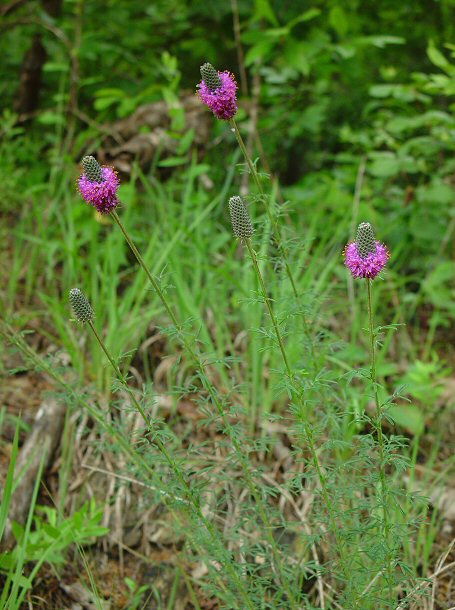Dalea purpurea Vent.
Purple Prairie Clover

Native
CC = 8
CW = 5
MOC = 73
© DETenaglia
Dalea purpurea Vent.Purple Prairie Clover | |
 |
Native CC = 8 CW = 5 MOC = 73 |
© DETenaglia |
|
Family - Fabaceae/Faboideae Habit - Perennial forb with a thick, dark brown to black, woody rootstock, sometimes with a thick, knotty caudex. Stems - Erect, sometimes slightly arched, to 80 cm, relatively few-branched toward the tip, occasionally unbranched, finely angled above the midpoint, the angles usually stronger and riblike below the nodes, glabrous or pubescent with inconspicuous, fine, curved hairs, rarely densely woolly, mostly lacking gland-dots.
Leaves - Alternate, odd-pinnate, stipulate, 1.5-4.0 cm long, sometimes appearing in fascicles, with 2-5 smaller trifoliate leaves at the base of the main leaf. Petioles punctate-glandular, villous, with adaxial groove. Blades with the rachis 10-20 mm long, gland-dotted, those of the main leaves with usually 5 leaflets. Stipules 2-4 mm long. Leaflets 10-24 mm long, 1.0-1.4 mm wide, linear to narrowly oblanceolate, angled to somewhat tapered at the base and tip, folded longitudinally, the upper surface glabrous, the undersurface gland-dotted and sometimes also sparsely and inconspicuously hairy, rarely densely hairy.
Inflorescence - Dense, indeterminate, cylindrical spikes 2-5 cm long, the stalk 1-6 cm long, the axis densely pubescent with short, bristly hairs (viewing the axis requires removal of flowers or fruits), with numerous bracts, persistent until the fruits are shed, 2.5-5.0 mm long, 1-2 mm wide, lanceolate-tapered to strongly tapered above an oblanceolate to ovate base, green or more commonly reddish-tinged above a membranous base, the expanded lower portion glabrous to sparsely hairy and sometimes gland-dotted, the tapered terminal portion densely hairy, with a pale thin band along the margin, this also hairy.
Flowers - Calyces with the tube 2.0-2.6 mm long, densely hairy, angled but not noticeably ribbed, not gland-dotted but often with minute reddish to brownish purple spots, the lobes 1.0-1.9 mm long, lanceolate to ovate, sometimes with minute reddish-purple spots, densely hairy. Petals pale to deep pinkish purple or reddish purple, the banner with the expanded portion 1.4-2.6 mm long, the wing and keel petals similar, attached along the rim of the stamen tube, the expanded portion 2.5-3.5 mm long. Stamens 5, the filament tube 2-3 mm long, the free filaments 2-3 mm long, the anthers orangish yellow.
Fruits - Short legumes, mostly included in the persistent calyx, 2.1-2.6 mm long, firm and densely hairy above the membranous basal portion, gland-dotted. Flowering - May - July. Habitat - Upland prairies, glades, tops of bluffs, forest openings, savannas, pastures, cemeteries, railroads, roadsides. Origin - Native to the U.S. Lookalikes - None. Other info. - At first glance the flowers and spikes of this plant appear somewhat uncharacteristic of most plants in the bean family. Closer examination reveals the papilionaceous floral structure. It is found across most of Missouri, but is uncommon or absent in the northwestern and southeastern corners of the state. Beyond Missouri it occurs within a broad swath in the central U.S., and also ranges northward into Canada. It is easily recognized when flowering by its distinctive inflorescences, which are a bit reminiscent of purple tutu skirts. Photographs taken at Alley Spring, MO., 6-13-03 (DETenaglia); also at Onondaga Cave State Park, Crawford County, MO, 6-19-2014; and near Tecumseh, Ozark County, MO, 7-2-2020 (SRTurner). |